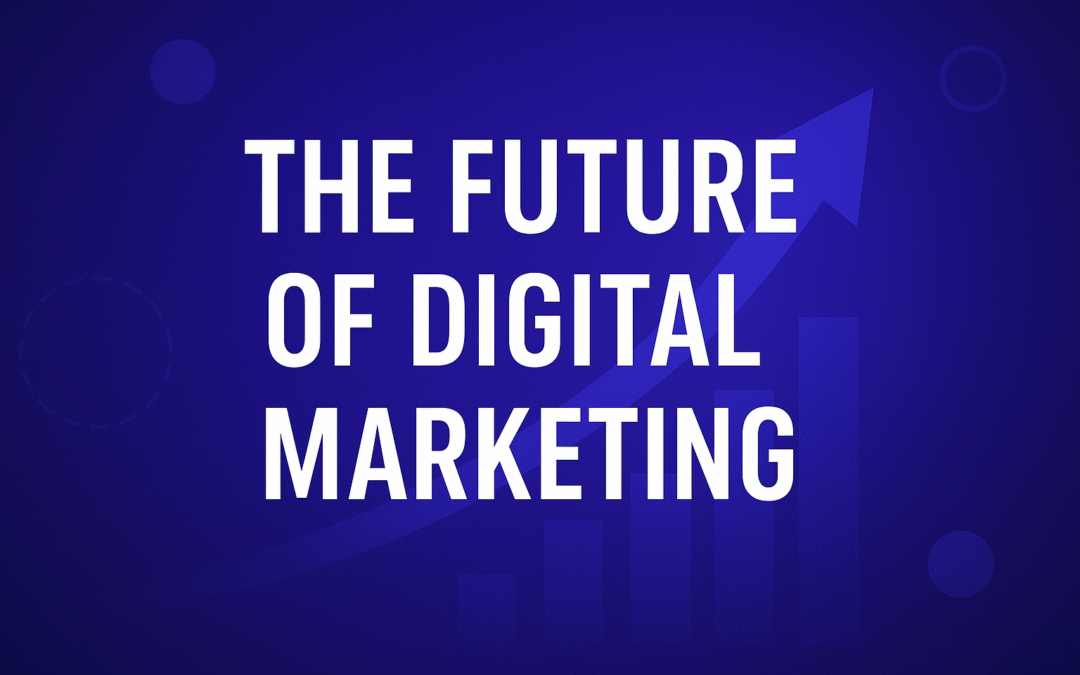Contents
- 1 Introduction
- 2 Why the Future of Digital Marketing Matters
- 3 Core Shifts Defining the Future of Digital Marketing
- 4 Key Strategies for the Future of Digital Marketing in 2025
- 5 Emerging Trends Shaping the Future of Digital Marketing
- 6 Real-World Examples of Future-Ready Digital Marketing
- 7 Action Plan for Businesses in 2025
- 8 Final Thoughts
Introduction
The future of digital marketing is evolving faster than ever. With changing consumer behavior, advancements in artificial intelligence, stricter privacy laws, and new platforms gaining momentum, businesses can no longer rely on the same tactics that worked a few years ago.
Digital marketing in 2025 is not just about being visible online, it is about being relevant, authentic, and adaptive. The brands that thrive are those that stay ahead of trends, use data intelligently, and connect with audiences on a deeper level.
This blog explores where the future of digital marketing is heading, the strategies that will matter most, and how businesses can prepare today to remain competitive tomorrow.
Why the Future of Digital Marketing Matters
Marketing has always been about connecting businesses with their audiences. But the way people discover, engage with, and trust brands has dramatically changed. A few decades ago, a television commercial or newspaper ad was enough to build awareness. Today, with consumers scrolling through endless content on multiple devices, it takes more than just visibility, it requires trust and value.
The future of digital marketing is shaped by three major forces:
- Technology: AI, automation, and analytics are changing how campaigns are created, delivered, and optimized.
- Consumer Expectations: People want personalized experiences, not generic ads. They also demand transparency and authenticity.
- Regulations and Privacy: With data protection laws like GDPR and India’s DPDP Act, marketers must strike a balance between personalization and respecting user privacy.
Ignoring these shifts could mean wasted budgets, declining reach, and a loss of consumer trust. On the other hand, businesses that adapt can position themselves as leaders in their industries.
Core Shifts Defining the Future of Digital Marketing
1. Personalization at Scale
Generic, one size fits all content is losing effectiveness. In 2025, personalization goes beyond adding someone’s first name in an email. AI powered tools now analyze browsing behavior, purchase history, and even sentiment to deliver hyper relevant content to each user.
2. Rise of Short-Form and Interactive Content
Platforms like Instagram Reels, YouTube Shorts, and TikTok have reshaped how people consume information. Interactive experiences—quizzes, polls, and AR filters—are gaining popularity because they actively involve the audience rather than passively feeding them information.
3. Search Beyond Google
Voice search, visual search, and even AI chatbots are redefining SEO. Users are asking Alexa, Google Assistant, or ChatGPT-like tools for recommendations instead of typing queries into a browser. Optimizing for these formats is becoming a necessity.
4. Privacy-First Marketing
Cookies are fading out, and brands must find ethical ways to collect data. First-party data strategies, loyalty programs, and transparent communication about data usage are becoming central to trust-building.
Key Strategies for the Future of Digital Marketing in 2025
With consumer behavior shifting and technology advancing rapidly, businesses need to rethink how they approach digital marketing. Here are the most effective strategies to focus on:
1. AI-Powered Marketing Automation
Artificial intelligence is no longer a buzzword—it is the backbone of modern marketing. From predictive analytics to content creation, AI tools can streamline processes while improving personalization.
- Customer Insights: AI helps identify patterns in consumer behavior, allowing brands to predict what customers want before they ask for it.
- Content Generation: Tools powered by AI can assist in creating blog posts, email campaigns, and even social media ads tailored to specific segments.
- Ad Optimization: Automated bidding and targeting ensure campaigns reach the right audience with minimal wasted spend.
Brands that embrace AI-driven marketing today will have a significant edge in the future of digital marketing.
2. Voice and Visual Search Optimization
More users are searching through voice assistants like Alexa, Siri, and Google Assistant. Similarly, platforms such as Google Lens and Pinterest Lens allow users to search through images.
To prepare for this:
- Use conversational keywords that reflect how people speak rather than type.
- Optimize product images with alt text, metadata, and schema markup.
- Focus on FAQ-style content, as voice search often delivers direct answers.
By adapting SEO to these new forms, businesses ensure visibility in an evolving search landscape.
3. Human-Centered Content Marketing
In 2025, content marketing remains king, but it has transformed. Audiences are tired of generic articles—they want depth, storytelling, and authenticity.
- Educational Blogs & Videos: Build authority by providing real value.
- Storytelling Campaigns: Share behind-the-scenes insights or customer stories to connect emotionally.
- Community-Driven Content: Encourage user-generated content (UGC) to build trust.
The future is about earning attention, not forcing it.
4. Omnichannel Experiences
Consumers move seamlessly between devices and platforms. They may discover a brand on Instagram, research it on YouTube, and complete a purchase through a mobile app.
Businesses must ensure that the experience feels connected across all touchpoints.
- Consistent branding and messaging.
- Smooth transitions between online and offline channels.
- Unified customer support across chatbots, emails, and calls.
Omnichannel strategies strengthen trust and encourage repeat engagement.
5. Influencer and Micro-Influencer Marketing
Influencer marketing continues to grow, but the trend is shifting toward micro-influencers (those with smaller but highly engaged audiences).
Why? Because people value authentic recommendations over polished celebrity endorsements. Partnering with influencers who share genuine connections with their followers ensures higher trust and better ROI.
6. Data-Driven and Privacy-Safe Marketing
As third-party cookies vanish, businesses must invest in first-party data:
- Loyalty programs that reward users for data sharing.
- Interactive tools like quizzes and surveys.
- Transparent policies that explain how data is used.
This builds trust while ensuring compliance with global privacy regulations.
Emerging Trends Shaping the Future of Digital Marketing
Beyond the established strategies, several emerging trends are redefining future of digital marketing and how businesses engage with audiences in 2025. These trends reflect deeper shifts in consumer expectations and technology.
1. Hyper-Personalized Customer Journeys
Instead of sending one-size-fits-all messages, brands now tailor entire customer journeys. For example:
- E-commerce websites adjust product recommendations in real time based on browsing behavior.
- Email campaigns are triggered by micro-actions, such as abandoning a cart or reading a blog.
- Chatbots provide customized support using AI-powered insights.
The goal is to make every touchpoint feel uniquely relevant to the user.
2. Rise of Short-Form Video & Live Commerce
Platforms like YouTube Shorts, Instagram Reels, and TikTok dominate user attention. In addition, live shopping events (where influencers or brands sell directly through livestreams) are gaining traction in India and globally.
This is not just entertainment—it’s an effective sales channel. Brands that integrate storytelling with commerce are winning big.
3. Sustainability and Ethical Marketing
Consumers are becoming conscious of the social and environmental impact of their purchases. Businesses are responding by:
- Highlighting eco-friendly practices.
- Offering sustainable packaging.
- Supporting social causes transparently.
The future of digital marketing is not only about selling but also about aligning with values that matter to the audience.
4. Community-First Marketing
Instead of focusing purely on reach, brands are building loyal online communities. For example, fitness brands are creating exclusive Facebook groups or Discord servers where users share progress and tips.
These communities drive long-term engagement, build trust, and create organic word-of-mouth.
5. Integration of AR and VR
Augmented reality (AR) and virtual reality (VR) are moving beyond gaming. Retailers now let customers virtually “try on” products before purchase. For instance:
- Furniture brands use AR to show how a sofa looks in a living room.
- Beauty companies allow users to test lipstick shades virtually.
This immersive experience not only improves conversions but also strengthens brand engagement.
Real-World Examples of Future-Ready Digital Marketing
Example 1: Nike’s Personalized Apps
Nike uses its fitness and shopping apps to create personalized experiences. It suggests workouts, recommends shoes based on activity, and integrates community features. This builds long-term customer loyalty.
Example 2: Zomato’s Data-Driven Campaigns
Zomato has mastered personalized push notifications. Their witty, behavior-based messages are a great example of how data and creativity can combine to capture attention.
Example 3: IKEA’s AR Shopping Tools
IKEA’s AR-powered app allows customers to visualize furniture in their own homes before purchasing. This reduces buyer hesitation and improves sales.
Example 4: Local D2C Brands in India
Smaller Indian direct-to-consumer brands leverage Instagram Reels and influencer partnerships to quickly scale visibility. By focusing on authenticity and micro-communities, they compete effectively with bigger players.
Action Plan for Businesses in 2025
Knowing the trends is one thing—acting on them is another. Here’s a step-by-step action plan to prepare your brand for the future of digital marketing:
Step 1: Audit Your Current Digital Presence
- Check whether your website, social media, and ads reflect consistent branding.
- Evaluate performance metrics (traffic, engagement, conversions).
- Identify gaps in personalization and customer engagement.
Step 2: Embrace AI and Automation
- Use tools like HubSpot, Mailchimp, or Zoho for email and CRM automation.
- Invest in AI-powered analytics to predict consumer behavior.
- Test AI-driven ad optimization to improve ROI.
Step 3: Strengthen SEO for the Next Generation
- Optimize content for voice search (FAQ-based, conversational queries).
- Use schema markup for visual and AI-driven search.
- Regularly update blogs with fresh, value-driven content.
Step 4: Focus on Community Building
- Launch brand-led forums, Discord servers, or LinkedIn groups.
- Encourage user-generated content to increase trust.
- Reward loyal customers with exclusive content or offers.
Step 5: Create a Personalization Framework
- Collect and organize first-party data (email signups, surveys, app usage).
- Segment audiences based on interests and behaviors.
- Deliver customized emails, product suggestions, and ads.
Step 6: Experiment with AR/VR and Interactive Content
- Use AR filters or product previews for Instagram campaigns.
- Host live shopping events on YouTube or Instagram.
- Add interactive quizzes, polls, or calculators to your website.
Final Thoughts
The future of digital marketing is not about chasing every new tool or trend—it’s about creating meaningful connections with customers while adapting to changing technologies and expectations.
Brands that stay rigid will struggle, while those that embrace personalization, automation, and authenticity will thrive. Whether it’s adopting AI, building communities, or experimenting with immersive experiences, the goal is the same: to stay relevant and valuable in the customer’s life.
If you’d like to explore how foundational marketing strategies can support your digital journey, you can check out our blog on Building a Personal Brand for insights on establishing trust and credibility online.
For additional global perspectives, this Forbes article on the future of digital marketing highlights expert predictions that align closely with these strategies.
Digital marketing in 2025 is not about working harder , it’s about working smarter. The brands that adapt today will be the ones leading tomorrow.

